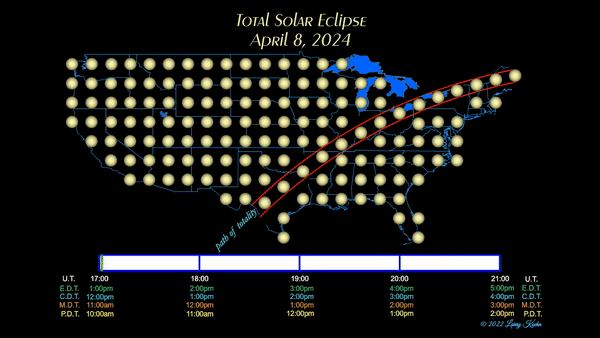
Mark Monday, April 8, 2024, on your calendar as "Solar Eclipse Day," for if the weather is fair, you should have no difficulty observing a partial eclipse of the sun from much of North America. This celestial event will be associated with a spectacular total eclipse in a narrow zone of the southern and eastern United States, in which the moon completely blocks out the disk of the sun. Truly, a "bucket list" event!
Meanwhile, viewers about 2,600 miles (4,200 km) on either side of the totality path will get a partial eclipse, with the moon initially making a slight dent in the sun's edge. The dent is the silhouette of the moon's limb, and in a properly filtered telescope, lunar mountains can be seen to roughen its curve. As the minutes pass, the dent slowly grows and deepens to turn the sun into a crescent. In a partial eclipse, the indentation appears to swing around the sun's limb, moving roughly from west to east.
You can watch the total solar eclipse live here on Space.com. And keep up with all the actions with our total solar eclipse 2024 live updates blog.
Related: Total solar eclipse April 8, 2024: The longest and most visible for the US in 100 years
Unlike a total eclipse of the sun, concentrating its excitement into a few fleeting minutes, a partial eclipse can be watched leisurely from wherever one happens to be.
During the eclipse, drawings and photographs can be made to show the moon's progress across the solar disk. The moon may temporarily hide sunspots. Observers with small telescopes can try to time the first and last instants when the moon's disk is visible against that of the disk of the sun.
Timings of precisely when the edge of the moon first touches or last leaves the sun's disk are less sharply defined than the beginning and end of a total solar eclipse, but are nevertheless useful. An arctic explorer of 150 years ago might have carefully timed these events for the chance of getting a reasonably good fix on the geographic longitude, after months of rugged dog sledding when a chronometer could no longer be trusted to provide Greenwich time. By observing the annular eclipse of Aug. 5, 1766, the famous navigator Capt. James Cook found for the longitude of an island off the coast of Newfoundland; a value that differs from the modern value by only 22 arc seconds.
Table of events
The table below provides local circumstances for 20 cities and provides the times for the beginning and end of the eclipse as well as the time of the maximum phase of the eclipse. The magnitude is defined as the fraction of the sun's diameter covered by the moon. Thus, for Chicago, Illinois, as much as 94.2% of the sun's diameter will be covered during early afternoon. In Honolulu, the greatest eclipse amounts to 28.6% less than an hour after sunrise.
When interpolating for a site between two cities, convert the times to the same time zone if they are not already.
The closer an observer is to the path of totality, the larger the percentage of the sun's diameter that will be covered by the moon at greatest eclipse. As the table shows, the eclipse is practically total at Cincinnati (magnitude 0.993), but at Juneau the moon will reach only about one-sixteenth of a way across the solar disk (magnitude 0.064). At these two cities, maximum eclipse will occur at 3:09 p.m. Eastern Daylight Time and at 10:33 a.m. Alaska Daylight Time, respectively.
Of the cities listed in the table, Juneau will have the shortest eclipse duration, just 46 minutes. The longest eclipse will occur at Monterrey and Houston, two hours, 42 minutes.
Across the western half of the continent, mid-eclipse will occur during the late-morning or midday, while farther east the phenomenon will take place during early-to-mid afternoon, high in the south-southwest sky.
Check out this fascinating animation of how the moon will appear to eclipse the sun across North America, courtesy of Larry Koehn of https://www.shadowandsubstance.com/
Eclipse effects
Many ancient peoples were terrified by the sun's misshapen appearance in a partial eclipse, believing that the sun was diseased, under attack or foretelling woe to its watchers.
If, for your area, the sun becomes at least 80 percent eclipsed, it will have the shape of an elongated crescent. Sunlight will then be coming only from the sun's redder limb regions; overall illumination on the ground will trend toward dusky. If you are within 110 miles (175 km) of the totality path, the moon will obscure 95 percent or more of the disk of the sun. The crescent sun will then shine with only 1/10 of the sun's normal total light, but this is less than a change than it sounds, since our eyes adapt readily to changing light levels.
The illumination will be no darker than on a bright overcast day. The quality of the light, however, may become unearthly. A clear sky should turn an abnormally deep blue and purer; the landscape transforms to a slightly alien, silvery or metallic look, about like that of a clear day on the planet Mars. The temperature may drop perceptibly, and chill breezes might also begin to blow.
Venus, shining at magnitude -3.9, should become easily visible 15 degrees to the lower right of the sun. Block the sun with your hand to search for it. Even Jupiter, fainter at magnitude -2.0, may be detectable 30 degrees to the sun's upper left if the air is very clear.
Shadows will also look a little odd — the sliver of remaining sun tends to produce sharper/crisper shadows.
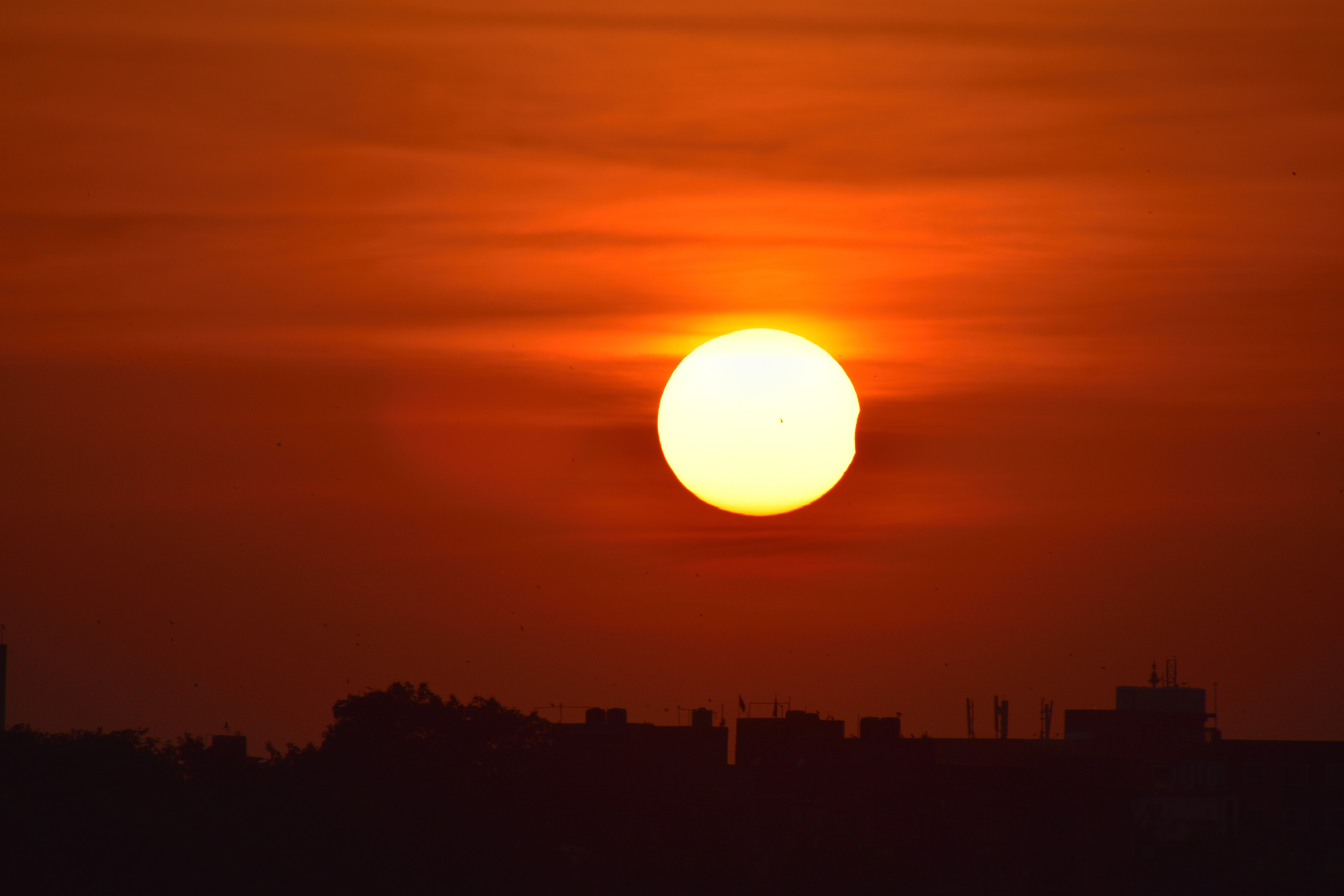
CAUTION: Anyone observing a partial eclipse should be extremely careful to avoid damaging their eyes.
Looking at the sun is harmful to your eyes at any time, and most people never do it. The danger that an eclipse poses is simply that it may prompt people to gaze or stare directly into the sun. A large partial eclipse can be especially insidious, not only because it is so attractive but because the sun's overall dimming makes it less painful to look at.
Although the moon may block off part of the solar disk, the surface brightness of the remainder is the same as when the sun is not eclipsed at all. The result can be "eclipse blindness," a tragic injury that has been recognized since at least the early part of the 20th century. A case is on record of a man suffering eye injury from only 30 seconds of naked-eye sun watching, and even a brief look is undesirable. Some victims of eclipse blindness have recovered their previous quality of eyesight after a few days or weeks, but others carry a permanent blurry or blind spot at the center of their vision for the rest of their lives.
Binoculars or a telescope, of course, greatly intensify the sun's power to blind. In past decades, hundreds of unwary people suffered permanent impairment of vision after watching eclipses with inadequate protection.
For direct telescopic or naked-eye viewing, a filtering system must be used to reduce the intensity of light by at least 100,000 times. Moreover, the filter must effectively stop the infrared and ultraviolet radiation that the observer cannot see.
Read more: How to observe the sun safely (and what to look for)
Do not watch the sun through thin clouds or haze, for a sudden clearing can cause retinal damage. (Even during the last moment before totality, the sun should not be viewed directly). It is a good idea to test filters and observing techniques before eclipse day.
There are several safe ways to watch. One is direct viewing through an approved solar filter, such as a #13 rectangular welder's glass (available for five or six dollars at welding supply shops). The sun appears green when viewed through a filter of this type. You can watch the eclipse for short periods through this filter.
At the very least you can purchase an inexpensive pair of "eclipse glasses" that are mounted in a cardboard frame; they only cost a couple of bucks. The filter that is typically used is made of a scratch resistant material called "black polymer" which creates an orange image of the sun. Another material that is sometimes used is an aluminized polyester film known as Mylar, which resembles tin foil, though much thinner. Using this filter, the sun looks pale blue. Just make sure that your glasses are certified by looking for "ISO 12312-2" printed on them.
If using a telescope, firmly mount the filter in front of the objective (not the eyepiece) so it cannot be knocked off, blown away or ruptured with a finger. Do not look at the sun through any other materials such as regular sunglasses, smoked glass or photographic filters. These may pass dangerous amounts of invisible infrared or ultraviolet rays.
Read more: Solar Eclipse Glasses: Where to buy the best, high-quality eyewear
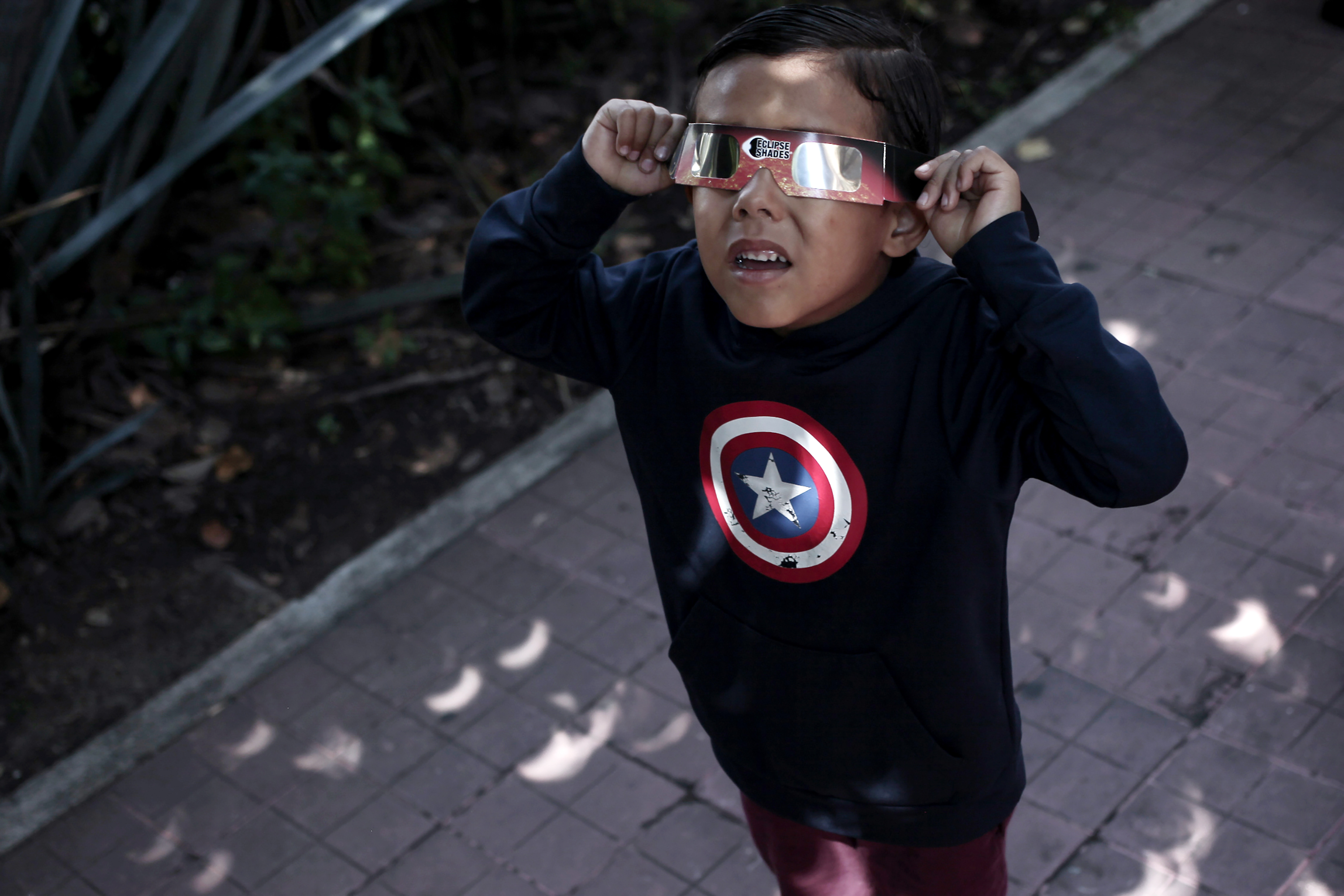
Projection is the safest method
Another method is to use an unfiltered telescope to project the sun's image onto a white screen or piece of cardboard or paper. This method is good for group viewing. A telescope can focus a large, sharp, bright image of the sun onto a screen mounted a foot or so behind the eyepiece. Don't look through or along the telescope while aiming it, and don't use more than a few inches of aperture. Otherwise, the intense heat could damage the instrument's internal parts. Cap the finder and keep eager spectators away from the eyepiece.
Some might see a profusion of the peculiar shape of "pinhole" images of the eclipsed sun dappling the ground in the shadows cast by trees and bushes, or formed by crisscrossing the fingers of one hand with the other to produce small apertures between your fingers, beneath which eclipse images will be seen on the ground. Even the holes in a straw hat can be used to project numerous small images of the eclipsed sun.
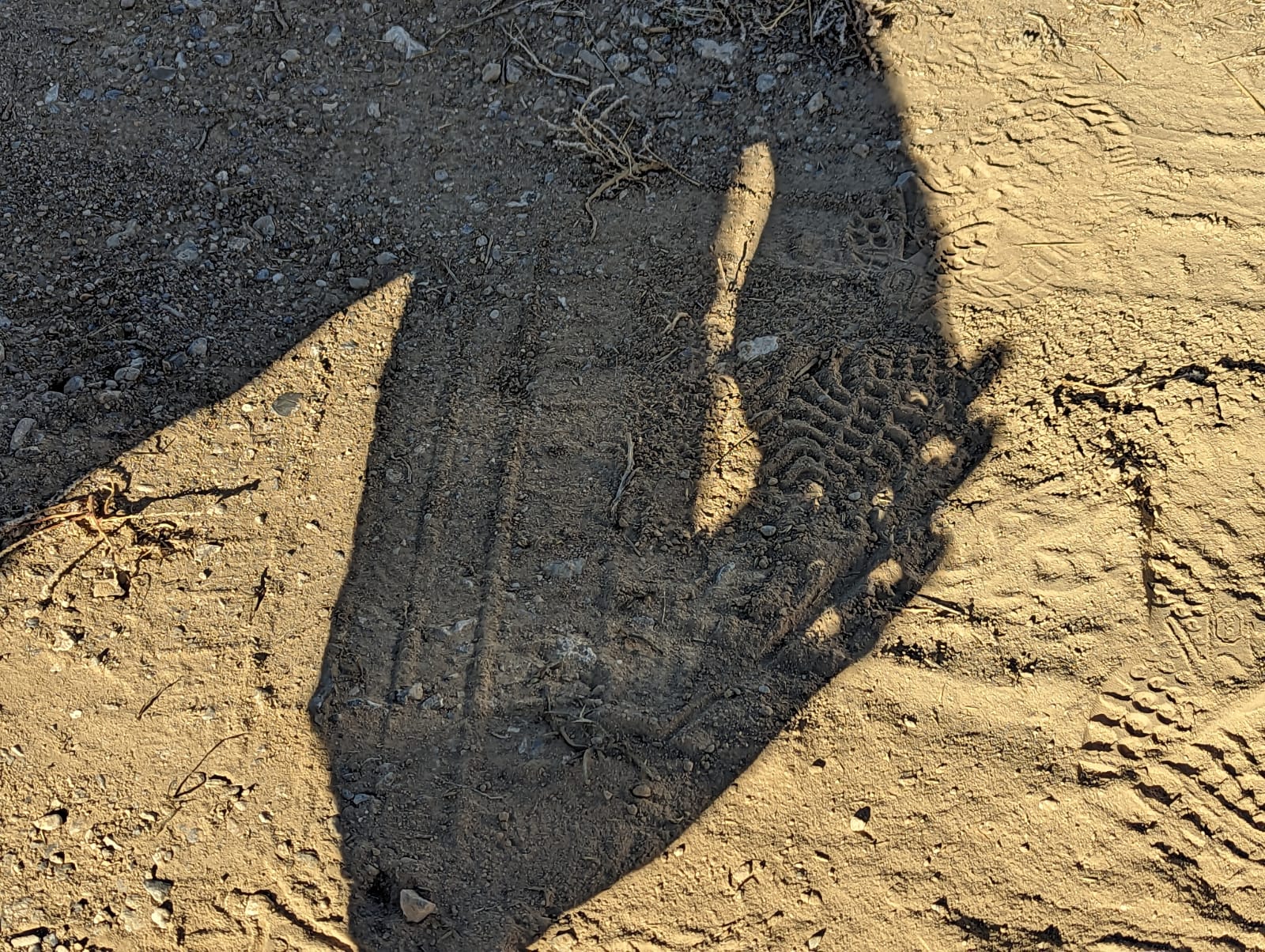
A 1-millimeter hole in a piece of cardboard or aluminum foil will cast a fairly clear solar image on a white surface three feet away.
Indoors, closed Venetian blinds in a south-facing window may produce rows of eclipse images, where sunlight passes through small openings. Also, a small hole pierced in a dark shade will cast a sizable image on a wall, floor, or screen. Thus, even a person confined indoors can watch this celestial phenomenon.
Even more effective is to set up a "pinhole reflector" made from a plane mirror, and a piece of paper (preferably dark colored) covering all but a spot about as large as a dime. The mirror is then mounted to reflect sunlight onto a nearby wall. The image will be one inch across for every 9 feet from the mirror. So (as an example) at a distance of 54 feet, a solar image will measure six-inches across. The reflected solar image thus formed can be studied close up by a large audience. Making the hole bigger increases the brightness but makes the image fuzzier; making it smaller improves the sharpness but makes the image appear dimmer. A large lump of modeling clay will hold the mirror at any angle and allows it to be re-aimed slightly as the sun moves.
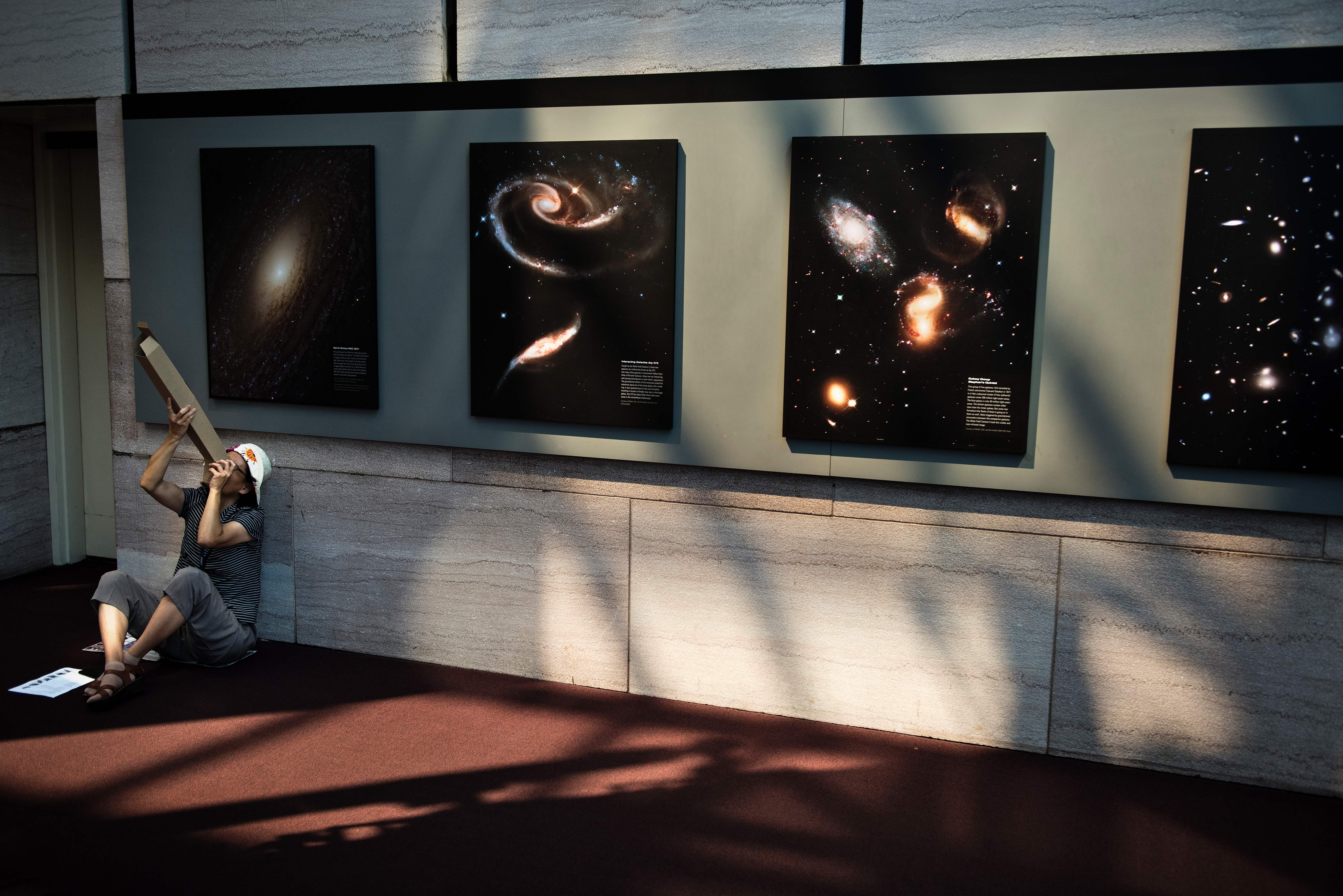
Television
If you are unable to be outdoors to see the eclipse, or if the day is cloudy and prevents you from seeing the sun, then your only option is to watch the eclipse live on television.
The April 8 eclipse will likely get lots of coverage by the TV news media, especially for places within the path of totality. Believe it or not, however, at past eclipses there are stories of parents who, for "safety reasons" would not permit their children to even watch the televised images of a solar eclipse because they were so confused by the dire warnings of the event!
Read more: Total solar eclipse 2024: How and where to watch online for free
If you decide to experience the total eclipse ...
As for totality itself, observers expecting to see it can enhance the view by dark-adapting their eyes during the preceding partial phases. Dark glasses will help, but better adaptation can be achieved by wearing a patch over one eye and removing it only after the sun's disk is completely covered by the moon. Also very effective are surplus red adaptation goggles used for military purposes during World War II.
Since the surface brightness of the solar corona is about equal to that of the full moon, during totality no filters are necessary for either naked-eye or telescopic viewing. But care should be taken to avoid exposure in direct sunlight when it returns (often as the diamond-ring effect) at the end of totality.
Joe Rao serves as an instructor and guest lecturer at New York's Hayden Planetarium. He writes about astronomy for Natural History magazine, the Farmers' Almanac and other publications.







